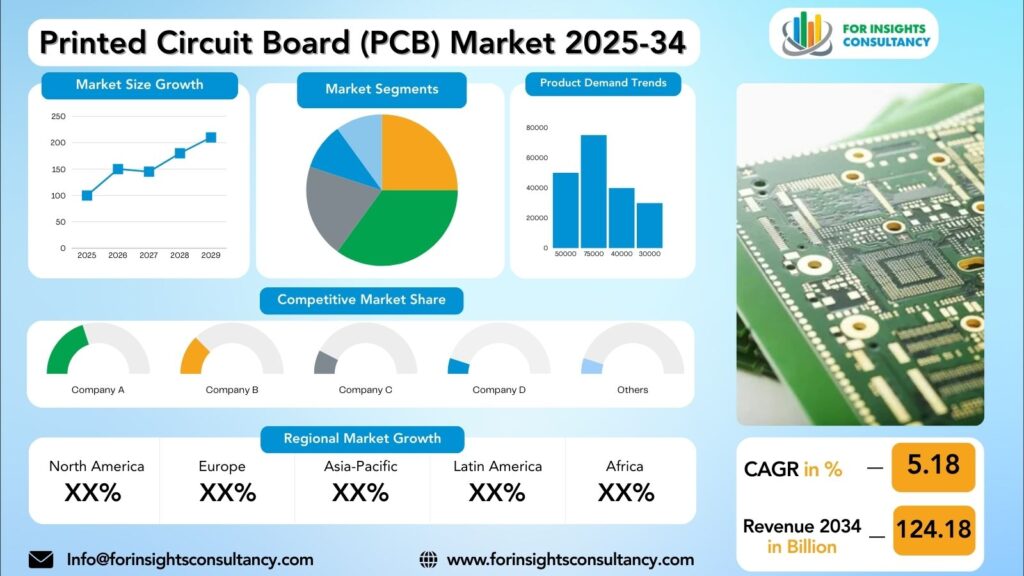
Printed Circuit Board (PCB) Market Size, Trends Analysis Research Report By Product Type (Standard Multilayer, Rigid 1-2 Sided, High-Density Interconnect (HDI)/Microvia, Flexible, Rigid-Flex, IC Substrates), By Substrate and Laminate Material (Rigid (FR-4, Metal-Core), Flexible Polyimide, High-Speed/High-Frequency (PTFE, LCP)), And By Application, By End-Use Industry, And By Region Global Market Analysis And Forecast, 2025-2034
Sep-2025 Formats | PDF | Category: Automotive | Delivery: 24 to 72 Hours
Printed Circuit Board (PCB) Market Is Forecast To Increase From USD 81.6 Billion In 2025 To USD 124.78 Billion By 2034, At A CAGR Of 5.18%.
Printed Circuit Board (PCB) Market: A Comprehensive OverviewAnd Future Developments
Printed Circuit Boards (PCBs) are crucial components in the electronics industry, providing a platform for electronic components to communicate and connect. The PCB market has seen steady growth in recent years due to the increasing demand for consumer electronics, automotive electronics, and industrial applications. As technology advances, the need for more advanced and efficient PCBs has also increased. Key players in the market include Samsung Electronics Co., Ltd., Nippon Mektron, Ltd., and TTM Technologies, Inc.
Future developments in the PCB market include miniaturization, increased automation, advanced materials, and the rise of IoT. Miniaturization is driven by the growing demand for smaller, more compact electronic devices, while automation will lead to higher efficiency and lower costs in PCB manufacturing. Advanced materials, such as flexible substrates and high-performance laminates, will enable the development of more robust and reliable PCBs. The rise of IoT is expected to drive the demand for PCBs as more devices become connected and require communication.
Printed Circuit Board (PCB) Market Dynamics
Growth Drivers
The rise of the Internet of Things (IoT) and the automotive industry’s shift towards electric vehicles and autonomous driving has led to a surge in the demand for PCBs. IoT devices require robust, reliable, and compact PCBs for seamless connectivity and data transfer. The PCB manufacturing industry has seen technological advancements, such as additive manufacturing and flexible PCBs, revolutionizing the industry. High-performance computing solutions, such as data centers, artificial intelligence, and machine learning, have driven the need for advanced PCB designs. High-density interconnect (HDI) PCBs and advanced materials like polymers and ceramics have further enhanced PCB performance and reliability.
The PCB industry is also shifting towards more eco-friendly practices, adopting green materials and processes, energy-efficient manufacturing techniques, and recycling old PCBs to reduce their environmental impact. To address supply chain disruptions, manufacturers are diversifying supplier networks, implementing Just-In-Time (JIT) inventory management systems, and investing in vertical integration. Digital twin technology is enabling manufacturers to simulate and optimize production processes, minimizing downtime and improving efficiency.
Restraints
The Printed Circuit Board (PCB) market faces several challenges, including market saturation, cost pressures, supply chain disruptions, technological obsolescence, and regulatory compliance. Market saturation is due to the increasing demand for electronic devices in various industries, leading to intense competition and price pressures. Manufacturers must find innovative ways to differentiate their products and add value to stay competitive.
Cost pressures are another significant restraint in the PCB market. Consumers expect more features and functionality in electronic devices at lower prices, which puts pressure on manufacturers to reduce production costs without compromising quality. Rising raw material prices, labor costs, and energy costs further add to the challenge of maintaining profitability. Manufacturers must constantly optimize their production processes and supply chain to remain cost-effective.
Supply chain disruptions, such as natural disasters, geopolitical issues, or pandemics, can significantly impact production and lead to delays in delivery, increasing costs, lower production efficiency, and customer dissatisfaction. Manufacturers must have contingency plans in place to mitigate these risks.
Technological obsolescence is a constant threat to PCB manufacturers, as rapid advancements in technology can render existing designs obsolete. To stay ahead of technological trends, manufacturers must invest in research and development, adapt production processes, and adhere to regulations governing hazardous substance use, waste disposal, and product labeling. Non-compliance can result in fines, legal disputes, and damage to reputation.
In conclusion, while the PCB market offers immense opportunities for growth and innovation, it also faces restraints that must be navigated carefully. By addressing these challenges, manufacturers can position themselves for success in the dynamic world of technology.
Opportunities
The demand for PCBs is expected to surge due to technological advancements such as 5G networks, IoT devices, and smart appliances. Companies that innovate and adapt to these changes will be well-positioned to capitalize on the growing demand for high-quality PCBs. The PCB market is a global industry, with emerging economies investing in infrastructure, providing new growth opportunities. Companies that offer eco-friendly PCB solutions, such as using recycled materials and minimizing energy consumption, will have a competitive edge. Collaboration and innovation are key factors driving success in the PCB market. By partnering with suppliers, manufacturers, and technology experts, businesses can stay ahead of the curve and develop cutting-edge solutions. The ability to adapt to changing consumer preferences and technological trends is crucial for long-term success in this competitive industry.
Challenges
The increasing complexity of PCBs due to technological advancements presents a significant challenge for manufacturers, who must find ways to produce intricate designs while maintaining cost-effectiveness. The market demands quick turnaround times, forcing manufacturers to streamline production processes and optimize supply chains. Quality control is crucial for ensuring the reliability of PCBs, as minor defects can lead to costly rework and product failures. Environmental regulations, such as the use of hazardous materials and waste disposal, add complexity and cost to the production process. To overcome these challenges, PCB manufacturers can invest in advanced manufacturing technologies, implement stringent quality control processes, build strong supplier partnerships, and stay updated on changing regulations and industry standards to ensure compliance and sustainability. By addressing these challenges, manufacturers can ensure the production of high-quality, cost-effective PCBs that meet customer expectations.
Printed Circuit Board (PCB) Market Top Companies Covered In This Report:
Evaluate The Strategic Positioning And Innovation Pipelines Of Leading Market Companies-From Multinational Enterprises To Disruptive Regional Firms. Understand How Key Players Are Innovating, Expanding, And Capturing Value, And Use Competitive Benchmarks To Plan Your Next Move.
- AT&S
- Unimicron
- Zhen Ding
- DSBJ
- Nippon Mektron
- Tripod
- TTM Technologies
- SCC
- Ibiden
- Hannstar Board
- Rhyming Technology
- Sanmina Corporation
Printed Circuit Board (PCB) Market News
Zhen Ding Technology Holding Ltd. (ZDT)
ZDT had a strong start to 2025, reporting record-high revenue for the first half of the year, with double-digit growth across its four main business segments. The company aims for record-high revenue for the entire year, driven by increasing demand for high-end IC substrates.
ZDT is continuing its global expansion, with its new factory in Thailand beginning trial production in May 2025 to serve the automotive and server markets. The company is also making significant investments in its Kaohsiung AI Park to expand capacity for high-end ABF substrates, a critical component for advanced packaging.
AT&S Austria Technologie und Systemtechnik AG
T&S is seeing an upward trend in its first quarter of 2025, with a 14% increase in revenue, which it attributes to the continuous market demand for IC substrates and PCBs for servers and high-performance computing. The company is also navigating a challenging market for e-mobility, where demand is currently low.
In June 2025, AT&S announced a long-term partnership with AEMtec to strengthen Europe’s microchip industry, focusing on microelectronics for the medical and semiconductor sectors.
Segmented View Of The Industry:
The Equipment Segment Holds The Largest Market Share Due To The High Cost Of Terminals, Antennas, And Modems. However, The Connectivity Services Segment Is Expected To Show The Highest Growth Rate.
The Printed Circuit Board (PCB) Market Is Mapped Through A Multidimensional Lens-Tracking Shifts Across Product Type, Applications, And Geographic Regions. This Segmented Approach Enables Businesses To Localize Their Growth Plans And Align Offerings With The Most Profitable Demand Centers.
Segmentation By Product Type
- Standard Multilayer
- High-Density Interconnect (HDI)/Microvia
- Flexible
- Rigid 1-2 Sided
- Rigid-Flex
- IC Substrates
Segmentation By Substrate and Laminate Material
- Rigid (FR-4, Metal-Core)
- Flexible Polyimide
- High-Speed/High-Frequency (PTFE, LCP)
Segmentation By End-Use Industry
- Consumer Electronics
- Automotive and EV
- Industrial Automation and Power
- Telecommunications and 5G
- Healthcare Devices
- Aerospace and Defense
Segmentation By Application
- 5G Infrastructure
- EV Powertrain and ADAS
- IoT and Wearables
- High-Performance Computing/Data Centers
Global Geographic Coverage:
Based On Recent Market Analysis, North America Is The Largest And Most Mature Market For Very Small Aperture Terminals (Vsat). Its Leading Position Is Driven By Significant Investments In Defense And Government Sectors And A Well-Established Telecommunications Infrastructure.
The Report Provides In-Depth Qualitative And Quantitative Data On The Printed Circuit Board (PCB) Market For All Of The Regions And Countries Listed Below:
North America
North America is a hub for technological innovation, with countries like the United States and Canada leading the way in electronic device development and production. The PCB market in this region is characterized by high sophistication and a strong emphasis on quality and reliability. The US, home to some of the world’s largest tech companies, drives demand for cutting-edge PCBs due to its strong focus on research and development, robust manufacturing infrastructure, and quick turnaround times.
Canada, a growing market with promising potential, has emerged as a key player in the global PCB market due to its skilled workforce and advanced technology capabilities. Its focus on sustainability and eco-friendly manufacturing practices has led to a surge in demand for environmentally conscious PCBs. With a strong emphasis on quality control and adherence to industry standards, Canada is poised for continued growth in the PCB sector. In conclusion, the PCB market in North America is vibrant, dynamic, and driven by innovation and a commitment to quality.
Europe
Germany, France, the United Kingdom, Italy, and Spain are key players in the European PCB market. Germany is a major player due to its emphasis on quality and innovation, with a robust manufacturing sector and numerous key players. French companies are known for their high-quality products and adherence to strict regulations. France also focuses on sustainability and eco-friendly practices, with cutting-edge research facilities dedicated to advancing PCB technology. The United Kingdom has a long history of innovation in the PCB industry, with strong ties to the global market and a reputation for delivering high-quality products on time and within budget. Italy is known for its creativity and design prowess, with a skilled workforce and advanced manufacturing facilities. Spain, with its strategic location and access to key markets, is a rising star in the European PCB market, offering cost-effective solutions and quick turnaround times. Spanish companies are known for their ability to deliver high-quality products at competitive prices.
Asia Pacific
China dominates the global PCB market due to its robust electronics manufacturing sector, large-scale manufacturing capabilities, skilled workforce, and advanced technology adoption. Major PCB manufacturers and suppliers in Shenzhen and Guangdong drive innovation and growth in the industry. Japan is a hub for technological advancements in PCB manufacturing, focusing on quality, precision, and reliability. Its strong emphasis on research and development and strict quality control measures have positioned Japanese manufacturers as leaders in the global market.
South Korea is also a key player in the PCB market, focusing on technological excellence and innovation. With a strong investment in research and development, skilled workforce, and advanced infrastructure, South Korean PCB manufacturers produce high-performance PCBs for various applications. With a growing demand for advanced electronic devices, South Korea continues to expand its presence in the global PCB market.
Taiwan is a leading hub for innovation and growth in the PCB industry, leveraging its strong semiconductor and electronics manufacturing sector. The country’s manufacturing capabilities, technological expertise, and strategic partnerships with global electronics giants have enabled Taiwanese PCB manufacturers to cater to diverse market needs. With a focus on flexibility, efficiency, and quality, Taiwan’s PCB industry is poised for continued growth and success in the global market.
Middle East And Africa
The Middle East is experiencing a surge in demand for PCBs due to the growth of electronics, automotive, and telecommunications industries. Countries like Saudi Arabia, UAE, and Qatar are key players in the PCB market. Saudi Arabia’s investment in the electronics sector and the presence of key electronics manufacturers have boosted market growth. UAE, particularly Dubai, has seen a rise in electronic device production, creating substantial demand for PCBs due to its strategic location and business-friendly environment. Africa’s rapidly expanding consumer electronics market is also driving the growth of the PCB market. Countries like South Africa, Nigeria, and Kenya are at the forefront of this development, offering lucrative opportunities for PCB manufacturers. South Africa’s robust electronics manufacturing industry and the government’s initiatives to promote local manufacturing have accelerated market growth. Nigeria, one of Africa’s largest economies, presents a significant market for PCBs due to its growing consumer electronics sector and focus on industrialization and technological advancements.
Reasons To Buy:
- The Research Would Help Top Administration/Policymakers/Professionals/Product Advancements/Sales Managers And Stakeholders In This Market In The Following Ways.
- The Report Provides Printed Circuit Board (PCB) Market Revenues At The Worldwide, Regional, And Country Levels With A Complete Analysis To 2034 Permitting Companies To Analyze Their Market Share And Analyze Projections, And Find New Markets To Aim For.
- To Understand The Most Affecting Driving And Restraining Forces In The Market And Their Impact On The Global Market.
- Major Changes And Assessment In Market Dynamics And Developments.
- The Objective Of The Printed Circuit Board (PCB) Market Report Is To Identify New Business Opportunities Using Quantitative Market Forecasts.
- Formulate Sales And Marketing Strategies By Gaining An Understanding Of Competitors, Their Positioning, And Strengths & Weaknesses.
Faq – What Global Leaders Are Asking
What Is The Growth Prospect For The Printed Circuit Board (PCB) Market By 2034?
Printed Circuit Board (PCB) Market Is Expected To Achieve A Stable Growth Rate With A Compound Annual Growth Rate (CAGR) Of About 5.18% From 2025 Through 2034.
What Is Driving The Growth Of The Printed Circuit Board (PCB) Market?
The growth of the Printed Circuit Board (PCB) market is driven by the increasing demand for electronic devices and the rapid adoption of new technologies like 5G, artificial intelligence, and the Internet of Things (IoT). The expansion of the automotive and electric vehicle (EV) sectors is also a major driver, as modern vehicles require a multitude of advanced PCBs for features like ADAS and battery management systems.
Who Are The Key Players In The Printed Circuit Board (PCB) Market, And What Are Their Market Shares?
The Printed Circuit Board (PCB) Market Includes Major Companies Like AT&S, Unimicron, Zhen Ding, DSBJ, Nippon Mektron, Tripod, TTM Technologies, SCC, Ibiden, Hannstar Board, Rhyming Technology, Sanmina Corporation., Others.
Specific Market Share Data Is Not Publicly Available And Is Typically Provided In Detailed, Proprietary Market Research Reports.
Which Regions Are Leading The Printed Circuit Board (PCB) Market Growth?
Asia-Pacific region is the largest market and is expected to have the highest growth in the PCB market. This growth is driven by its established manufacturing base and rising demand from key sectors in countries like China and India.
Customization: We Can Provide Following Things
1) On Market More Company Profiles (Competitors)
2) Data About Particular Country Or Region
3) We Will Incorporate The Same With No Additional Cost (Post Conducting Feasibility).
Any Requirement Contact Us: Https://Www.Forinsightsconsultancy.Com/Contact-Us/
Table of Contents
For TOC Contact us: https://forinsightsconsultancy.com/contact-us/







